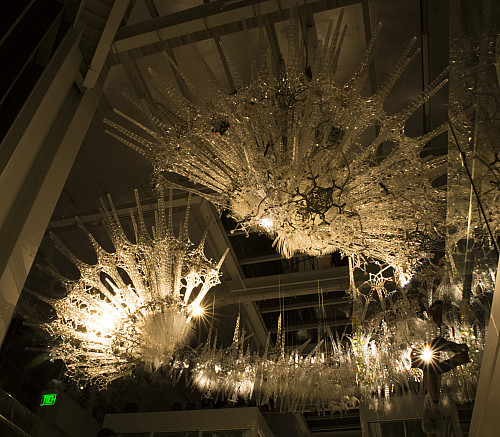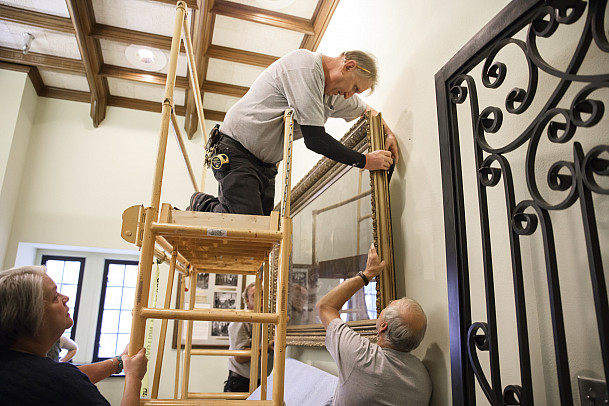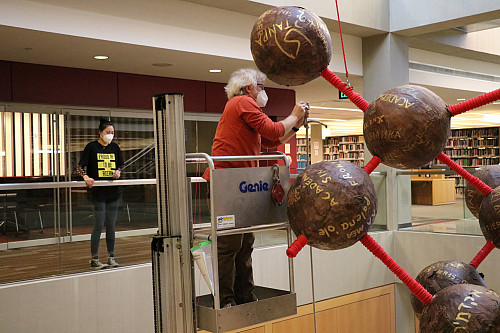Impact through art: IU’s first curator of campus art retiring
By Teresa Mackin
December 10, 2021
Walk with Sherry Rouse through any building on any IU campus, and you may hear a story about each piece of art in that building. Each piece was chosen to be there, either by Rouse or someone on her team.
“Every piece adds to the story of the university,” Rouse said. “It makes every one of us appreciate where we are more, whether we realize it or not. There’s a true feeling of warmth the art provides that these walls can’t do. It’s not just art; it’s part of the make-up of the university. It’s part of our heritage, and it’s part of our education.”

As the curator of campus art, Sherry Rouse oversees around 14,000 pieces of art on IU campuses and properties across the state and beyond: That includes sculptures, statues, oil paintings, murals, works on paper, photography, you name it. Rouse was the first curator of campus art for Indiana University: Her team started with just her and some graduate students. She now leads a team of six, and she’s retiring at the end of December.
“If you have a building with no art, you have an empty building,” she said. “Art makes that hospital comfortable to sit in. Art makes waiting rooms and conference rooms interesting to be inside. We help people enjoy walking down the halls of a building, because art invokes memories. If I move something, I hear about it. And I move things a lot.”
“Every piece adds to the story of the university. It makes every one of us appreciate where we are more, whether we realize it or not.”

This wasn’t her original path. Rouse majored in K-12 education during her undergraduate studies, but then ended up starting a job at an arts gallery and learned to frame pictures. The rest is history, so they say. She got her master’s degree in arts administration from IU Bloomington and started her Ph.D. in philanthropy; it was during that time that she worked at Indiana Memorial Union. Her job was to take care of the artwork there.
But it wasn’t until she was working at IU in risk management that her job as curator of campus art started, in 1999.
“I got this job because a painting had been stolen,” she said. “One of our curators went to visit a donor and saw a painting that used to hang in the auditorium. The donor had purchased it in good faith, but someone had stolen it and resold it! That’s when they hired me to start to inventory all the art across IU.
“At first, my job was simply to go out and count paintings. But as I found more pieces, and then started to collect others and find more in storage, I wondered what to do with all of them. I found things in closets, things sitting on floors, some people would say they didn’t like something. I started to reconfigure it, to reframe items, to place them other places, and my job started to become what it is today.”

Rouse’s job not only includes picking out pieces for new buildings and reconfiguring and moving around others, but also conservation: keeping pieces safe. She said a lot of technicalities you can’t see are involved in protecting the artwork around the campus, like special glass or other safety features. When leaders change offices or titles, her team moves the artwork or anticipates what should be there. Her team also works with donors, helping people find a way to give to IU and make it more beautiful at the same time.
“Working with donors is one of the most rewarding parts of the job,” she said. Rouse recalls working with Elinor “Lin” Ostrom, the late Nobel Prize winner and global leader in the arena of political economics, property rights and collective action, as she donated items from the home she shared with her husband, Vincent Ostrom, to Indiana University later in life.
“There are totem poles, desks and beautiful works of art from the Ostroms’ home that tell the story of their lives. It’s a way to share their lives with the university, and it’s truly history all around campus.”

That history continues to evolve as new buildings are constructed and new art must be chosen.
Take, for example, the new Regional Academic Health Center and the Mies building for the Eskenazi School of Art, Architecture + Design in Bloomington. As both were built, Rouse’s team helped with the artwork there.
“Sometimes I sit in on the original planning committees with the architects, and we talk about what might be meaningful in that space,” she said. “For the Mies building, we are showcasing artwork from emeriti faculty, which is going to be a really interesting display.”
“It’s amazing how many people have a painting they remember from their years at IU. Those connections to art are very real and really special.”
One of Rouse’s favorite collections lives at IU Southeast; it features a group of painters called the Wonderland Way Art Club, which included more than 300 artists at one time living in or near New Albany, Indiana. The collection is made up of donated works created by Wonderland Way artists and supported through generous contributions.

What strikes her is how art is seen differently by different people – and appreciated for different reasons. Rouse talks about a collection of sculptures by Morton C. Bradley Jr. that are housed across several campuses, including IUPUI and IU Bloomington.
“These are beautiful because they examine color theory and geometry. And mathematicians look at them differently than someone at the art museum, and people at the law school see them differently than those at Luddy Hall. Yet all over, you see people stopping to look at them. They also offer a bit quiet; they give you a minute to think about something besides that test you need to be studying for.”
She looks back at the collection at the IMU on Bloomington’s campus, as well.
“The building is a collection of artwork from Hoosier artists, and it’s really special,” Rouse said. “When paintings started to need conservation, as we asked people for donations to help, we’d ask them to adopt a painting. Every single alum had a favorite painting. They remembered it from where they sat and studied, or where they walked regularly. It’s amazing how many people had that painting they remembered from their years at IU. Those connections to art are very real and really special.”

“One of the greatest treasures on the IU campus is the collection of art which hangs in the public spaces of the Indiana Memorial Union. Sherry Rouse, from the beginning of her career with the IMU, recognized the significance of this and has been a leader in preserving, documenting and expanding the collection for the university family and guests to enjoy,” said Winston Shindell, who was the director of the IMU for more than 20 years. “Sherry was also a leader in planning an endowment campaign to preserve and protect the pieces for future generations to enjoy.
“She is a true professional in every sense of the word, and it has been my good fortune to know and work with her during my tenure as executive director of the IMU and the IU Auditorium. Her institutional memory will be sorely missed.”
Rouse does have a favorite project that stands out: collecting portraits of the “Women of IU,” a collection that celebrates the women who made Indiana University what it is today.
“We brought in these portraits from all over, and we told so many of the stories of these amazing women. We now rotate them in and out of the union, and it’s a really nice thing to celebrate after all these years.
“We also are working to augment our collections to include representations of all people: from all cultures and backgrounds and sexual orientation. We’re working to include and find images we haven’t had, so we can be representative of everyone who makes up Indiana University.”
Rouse said they’ve been working with students to tell the stories of who we are at IU; one example is through the photographs showcased in the Georgian Room at the IMU.

“Watching Sherry move throughout this university, beautifying as she goes, has been both an honor and a privilege,” said Katie Chattin, assistant curator of campus art, who has worked with Rouse for 10 years. “Not everyone gets to learn from the best, and I have been so very fortunate to have her has a mentor and a friend. IU is a better and more captivating place because Sherry was here, and I know I can speak for the entire system when I say we are so incredibly grateful.”
As Rouse looks ahead to retirement, she looks back on her work as the first curator of campus art. What has changed? Data and photos and measurements of each piece surely have gotten easier to enter in the system over the years. Technology has changed. The art itself has moved and changed tremendously over the years. It still doesn’t stop taking her breath away at some moments when walking by.
But what will she miss the most?
“The people,” she said with a smile. “I can come see the art. But it’s the people of IU I’ll miss the most. It’s been the most rewarding job. I’m so grateful.”
Teresa Mackin is a communications consultant with IU Studios.